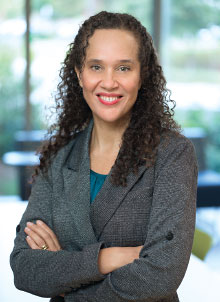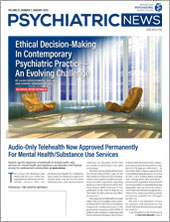Although they are called “microaggressions,” these subtle, yet denigrating, messages targeting an individual’s race or identity can have an outsize effect, said Kupiri Ackerman-Barger, Ph.D., R.N., associate dean for health equity at the University of California, Davis, at APA’s virtual Mental Health Services Conference.
The term was first coined by the late Harvard psychiatrist Chester Pierce, M.D., in the 1970s, but unfortunately microaggressions remain all too common, even in health care settings, Ackerman-Barger said. Repeated exposure to microaggressions can result in depression and anxiety, physical health problems, and even suicidal ideation for the recipient. She gave the following examples from her work in academic medicine:
•
A Black student was told that he was accepted into medical school only because of his race, and “It is really hard for White men to get accepted these days.”
•
A student with they/them pronouns on their badge was told “Young people these days can’t even decide if they’re a boy or a girl.”
•
A Latino student was told “You’re a credit to your race.”
•
A Native American student was asked “Why don’t you tell your classmates about the health issues of Native Americans?”
Research shows that in the health care setting, microaggressions perpetuate a lack of trust in health care professionals. If left unchecked, microaggressions can ultimately impact patient care and the prioritization of resources, she added. “If individuals, families, or communities are experiencing microaggressions from health care professionals, they are going to be less likely to keep appointments, consider preventative measures, or obtain diagnoses. They’re more likely to wait until later in their illness to seek care, and of course there are health consequences to that.”
During a microaggression, there are threats to the reputations of all involved, Ackerman-Barger and Negar Nicole Jacobs, Ph.D., wrote in the December 2020 Academic Medicine. The recipient may be seen as oversensitive, the source as racist, and the bystander as cowardly.
Ackerman-Barger and Jacobs developed a framework for dealing with microaggressions they call the Triangle Model; its goal is to give all those involved the opportunity to restore their reputations, repair relationships, and cultivate a climate of inclusion. Being familiar with the model also helps minimize one’s chance of committing a microaggression, she said. “I can guarantee you have been the source of a microaggression, and you will be again, and so how are you going to address that?”
With the Triangle Model, there is a role for each party involved: recipient, source, and bystander. For those on the receiving end of a microaggression, she advises them to remember to ask clarifying questions that come from a place of curiosity, not judgment, and to try to stay objective when explaining the impact of the microaggression. Ackerman-Barger said microaggressions don’t always have to be dealt with in the moment, and taking time to reflect on the situation may help recipients decide how to best respond. When there is a power dynamic, such as when the source is a professor responsible for the individual’s grade, the recipient may choose not to respond to the source and instead report the incident to school leadership or through the school’s reporting mechanism.
When individuals say something that is out of alignment with their internal values, she advises them to acknowledge their own bias and to explore what happened. For example, when no one laughs when a person makes what he or she thinks is a joke, that is valuable feedback that should be explored. She advises people to apologize in an authentic way for their microaggressions by focusing on the impact of their words, not their intention.
“Whether it was your intention or not [to cause harm], this is an opportunity for you to learn about somebody else’s experience. … An apology should be about recognizing someone else’s pain,” she said. “When people tell you what happened and how it impacted them, that’s a gift. They’re trusting you to be able to learn and grow from that, so you want to say thank you for that feedback.”
Witnesses or bystanders to a microaggression also have an important role, Ackerman-Barger said. For them, the model emphasizes the importance of awareness. Others may “experience something as a microaggression that we may not interpret that same way. It doesn’t mean that it’s not a microaggression,” she said. “We never want to tell people to grow a thicker skin. … There could be open wounding or scar tissue there. Often what a recipient needs is validation and to be believed.”
She advises bystanders to inquire what a source meant by a comment and to respond with empathy, avoid judgment, and focus on teachable moments and community building. She advises starting with “I” statements, such as “I know you didn’t intend to stereotype anyone, but as your friend, I wanted you to know that what you said could be interpreted that way.” ■
“The Microaggressions Triangle Model: A Humanistic Approach to Navigating Microaggressions in Health Professions Schools” is posted
here.

